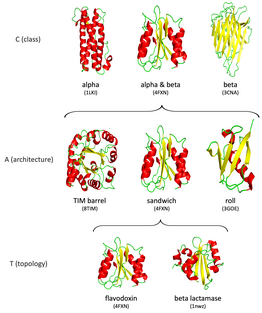|
CATH database
 The CATH Protein Structure Classification database is a free, publicly available online resource that provides information on the evolutionary relationships of protein domains. It was created in the mid-1990s by Professor Christine Orengo and colleagues including Janet Thornton and David Jones,[2] and continues to be developed by the Orengo group at University College London. CATH shares many broad features with the SCOP resource, however there are also many areas in which the detailed classification differs greatly.[3][4][5][6] Hierarchical organizationExperimentally determined protein three-dimensional structures are obtained from the Protein Data Bank and split into their consecutive polypeptide chains, where applicable. Protein domains are identified within these chains using a mixture of automatic methods and manual curation.[7] The domains are then classified within the CATH structural hierarchy: at the Class (C) level, domains are assigned according to their secondary structure content, i.e. all alpha, all beta, a mixture of alpha and beta, or little secondary structure; at the Architecture (A) level, information on the secondary structure arrangement in three-dimensional space is used for assignment; at the Topology/fold (T) level, information on how the secondary structure elements are connected and arranged is used; assignments are made to the Homologous superfamily (H) level if there is good evidence that the domains are related by evolution[2] i.e. they are homologous.
Additional sequence data for domains with no experimentally determined structures are provided by CATH's sister resource, Gene3D, which are used to populate the homologous superfamilies. Protein sequences from UniProtKB and Ensembl are scanned against CATH HMMs to predict domain sequence boundaries and make homologous superfamily assignments. ReleasesThe CATH team releases new data both as daily snapshots, and official releases approximately annually. The latest release of CATH-Gene3D (v4.3) was released in December 2020 and consists of:[8]
Open-source softwareCATH is an open source software project, with developers developing and maintaining a number of open-source tools,[9] which are available publicly on GitHub.[10] References
|
|||||||||||||||||||||||||||||||||||||||||||